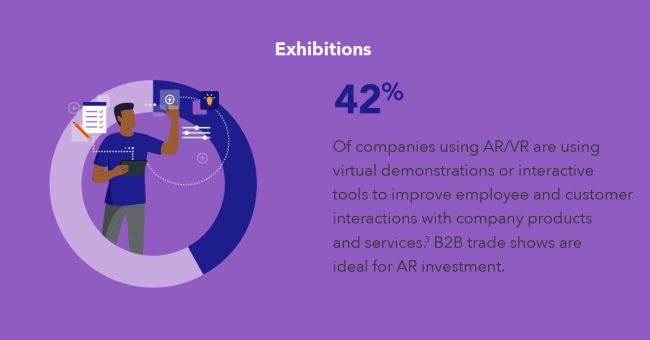Katy is the founder of Social Startup Consulting, a sales and marketing consulting firm that helps startups and social enterprises build strong, happy and highly productive sales teams. Her past roles include launching a startup incubator, building out the UberEATS Seattle Launch team from the ground up and serving as brand strategy expert for a portfolio of top brands at Amazon.com. Katy is passionate about helping businesses, particularly social enterprises, build lasting, meaningful and profitable connections with their customers and other stakeholders.
Topics
How Augmented Reality Is Reshaping the Sales Process

Augmented Reality (AR) technology is an idea that has captured the imaginations of many since its invention in the 1960s. I first came across a practical business application for AR technology in a business setting in 2014 when I was working in a brand strategy role for Amazon’s consumer electronics division. We found that many customers were interested in buying televisions online but worried about how each TV would look and fit into their living rooms upon delivery. One of my colleagues began experimenting with an AR application that projected the TV onto the wall of a customer’s home so they could virtually “see” if that TV was the right fit. At that time, we considered this technology to be an interesting experiment and looked forward to rolling it out to customers to see if it would influence their purchasing behavior.
Top Drivers for Deploying AR
Since observing the early launch process of AR technology at Amazon, AR has been reshaping the sales process in several industries throughout the U.S. In December 2020, CGS published the results of a survey of 100 operational business leaders who were asked about their top drivers for deploying augmented reality solutions. 41 percent responded that their top driver was to provide new ways to sell and demo products. Other top drivers for deploying AR included heightened cost savings (30 percent), improved customer satisfaction (25 percent) and extended expert reach (16 percent).
Growing Customer Demand for AR
Clearly, there is a growing demand for AR technology, and that demand is growing in a variety of industries ranging from retail to home improvement. In a survey of 1,000+ customers, nearly half (42 percent) stated that they would be interested in using technology in which an expert guided them through steps either via a phone or tablet to demo or fix an item. The 35- to 44-year-old age group lead the way with 51 percent expressing interest in AR-enabled expert guidance. This age group was closely followed by the 25–34 age group where 45 percent expressed interest.
The increasing rollout of AR technology is especially relevant in our current COVID world where touching or trying things physically is more difficult than in the past. For example, the challenge of closed dressing rooms in a Zara store could be assuaged with AR technology that allows customers to “try on” a piece of clothing before purchasing. The CGS study also showed that 61 percent of shoppers prefer stores that offer augmented reality experiences. If shoppers could experience a product in AR, 71 percent would return more often and 40 percent would pay more. (See key results of the CGS study.)
The AR Evolution of the Sales Process
In the past, a significant amount of sales volume was achieved either through relationship-driven or try-before-you-buy approaches. This often involved in-person demos for complicated products that offered the ability to touch and experience products before buying. The adoption of the internet spurred major changes in sales strategies for many businesses, especially retailers, which had to transition their marketing goals away from generating foot traffic and toward online landing pages and targeted video ads.
Today businesses are facing another major shift in the ways they can interact with and sell to consumers. According to the CGS study, the 3 top current use cases for AR are product presentations, exhibitions and AR advertisements. Newgenapps.com cites that there were more than 1 billion AR users in 2020, and that number is only projected to increase. By 2025, 14 million Americans are estimated to regularly use smart glasses on their jobs, according to Mobidev.biz, and 67 percent of media agency execs want more AR and VR ads incorporated into their digital marketing campaigns according to vibrantmedia.com.
The Start of Something Bigger
While the technology has been around for a while, the tipping point for AR to become more mainstream is now. It’s clear the market for AR in sales enablement will continue to grow. Whatever use cases we see today will expand and change shape as we work toward sales models for the future.
Business leaders will want to stay ahead of the trend, strategizing how to implement AR technology into their sales process as they work to gain competitive advantage in this rapidly evolving sector. To learn more ways that AR can enable sales and business growth, check out our infographic. And to check out the full results of CGS’ latest study on how AR is reshaping the sales process, get your copy of the full report.
Katy is the founder of Social Startup Consulting, a sales and marketing consulting firm that helps startups and social enterprises build strong, happy and highly productive sales teams. Her past roles include launching a startup incubator, building out the UberEATS Seattle Launch team from the ground up and serving as brand strategy expert for a portfolio of top brands at Amazon.com. Katy is passionate about helping businesses, particularly social enterprises, build lasting, meaningful and profitable connections with their customers and other stakeholders.

